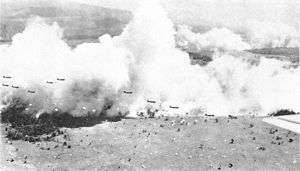503rd Infantry Regiment (United States)
| 503rd Parachute Infantry Regiment 503rd Airborne Infantry Regiment 503rd Infantry Regiment | |
|---|---|
|
Coat of arms | |
| Active |
1941–1945 1951–1984 1986–present |
| Country |
|
| Branch |
|
| Type | Airborne forces |
| Role | Parachute infantry |
| Size | Regiment |
| Nickname(s) | The Rock |
| Engagements |
World War II Vietnam War Afghanistan Operation Iraqi Freedom |
| Decorations | Presidential Unit Citation |
| Commanders | |
| Notable commanders | George M. Jones |
| Insignia | |
| Distinctive unit insignia |
 |
| U.S. Infantry Regiments | |
|---|---|
| Previous | Next |
| 502nd Infantry Regiment | 504th Infantry Regiment |
The 503rd Infantry Regiment, formerly the 503rd Parachute Infantry Regiment (PIR) and the 503rd Airborne Infantry Regiment (AIR), is an airborne forces infantry regiment of the United States Army. The regiment served as an independent regiment in the Pacific War during World War II; at Fort Campbell, Kentucky; in Okinawa, Japan; and in Germany. Regimental elements have been assigned to the 2nd Infantry Division, the 11th Airborne Division, the 24th Infantry Division, the 82nd Airborne Division, and the 173rd Airborne Brigade Combat Team. Regimental elements have participated in campaigns in the Vietnam War, Operation Enduring Freedom–Afghanistan, and Operation Iraqi Freedom. The regiment claims 15 Medal of Honor recipients: two from World War II, 10 from Vietnam, and three from Afghanistan. A parent regiment under the U.S. Army Regimental System. The regiment's 1st and 2nd Battalions are active, assigned to the 173rd Airborne Brigade, based in Vicenza, Italy.
Current Status of Regimental Elements
- 1st Battalion, 503rd Infantry Regiment: Active, assigned to the 173rd Airborne Brigade, based in Vicenza, Italy
- 2nd Battalion, 503rd Infantry Regiment: Active, assigned to the 173rd Airborne Brigade, based in Vicenza, Italy
- 3rd Battalion, 503rd Infantry Regiment: Inactive since 1973
- 4th Battalion, 503rd Infantry Regiment: Inactive since 1973
- Company E, 503rd Infantry Regiment: Inactive since 1957
- Company F, 503rd Infantry Regiment: Inactive since 1957
- Company G, 503rd Infantry Regiment: Inactive since 1957
- Company H, 503rd Infantry Regiment: Inactive since 1957
- Company I, 503rd Infantry Regiment: Inactive since 1957
History
World War II
On 14 February 1942, just two months after the American entry into World War II, the 503rd Parachute Infantry Regiment was formed, under the command of Lieutenant Colonel William M. "Bud" Miley. The regiment's 1st and 2nd Battalions were formed at Fort Benning, Georgia, from the 503rd and 504th Parachute Battalions, respectively. En route to Australia, the 503rd picked up a third battalion in Panama, where they had been undergoing jungle training. [1] Unlike many other airborne units, which were deployed in the European Theater of Operations (ETO), the 503rd was the first airborne regiment to fight in the Pacific, and as an independent unit.
The unit's first operation was an unopposed landing at Nadzab, in the Markham Valley, New Guinea, on 5 September 1943. Although the landings were unopposed, the troops were later attacked by enemy bombers from the air. The 503rd's deployment helped force the Japanese evacuation of a major military outpost at Lae. During their overland withdrawal, the third battalion of the 503rd had a major skirmish with the Japanese rear guard.
On 3–4 July 1944, 1st and 3rd Battalions of the 503rd were delivered by parachute to Kamiri Airfield on the island of Noemfoor off the coast of Dutch New Guinea, sustaining significant casualties from the jump. To reduce further casualties, the 2nd Battalion was delivered amphibiously. At the Battle of Noemfoor, the 503rd played a major role in the elimination of the Japanese garrison on that island.[2] As a result of his heroic actions during the battle, paratroop Sergeant Ray E. Eubanks was posthumously awarded the Medal of Honor. Airfields constructed on Noemfoor after its capture enabled the advance of Allied troops from New Guinea to the Philippines.
Following a non-combat landing on the island of Leyte in the Philippines, the 503rd Regimental Combat Team (RCT) made a major amphibious landing on Mindoro Island in the central Philippines on 15 December 1944. Originally, it was intended for the 503rd to jump on Mindoro, but due to inadequate airstrip facilities on Leyte, an airborne landing was not possible. During the Battle of Mindoro, the 503rd was subjected to intense air and naval actions, at one point being shelled for 25 minutes by a Japanese naval task force. One company of the 503rd RCT engaged in a fierce battle against a company-size Japanese force defending an enemy air raid warning station on the north end of the island. The success of the Mindoro operation enabled the United States Army Air Forces to construct and operate air strips and forward air bases to support later landings in the Philippines at Lingayen Gulf, Luzon.
On 16 February 1945, the 503rd RCT jumped on Fortress Corregidor ("the Rock") to liberate that island from occupying Japanese forces. Braving intense fire, the paratroopers rushed forward and overcame the heavy blockhouse defenses, dropping explosives into embrasures to kill hidden Japanese gunners. For its successful capture of Corregidor, the unit was awarded a Presidential Unit Citation and received its nickname, "the Rock Regiment" from it. The regimental insignia was designed by Private First Class Thomas M. McNeill while recuperating from his injuries and dengue fever, hepatitis, and malaria on Mindoro Island, following the battle of Corregidor.
Post-WWII history
Deactivated at Camp Anza, California, in December 1945, it was reactivated and redesignated as the 503rd Airborne Infantry Regiment in February 1951 and assigned to the 11th Airborne Division at Fort Campbell, Kentucky, following the departure of the 187th Airborne Infantry Regiment to Korea as a separate airborne regimental combat team. In 1956 the 503rd went with the rest of the 11th Airborne Division to posts in southeastern Germany.
The 503rd was relieved on 1 March 1957 from assignment to the 11th Airborne Division and was concurrently reorganized and redesignated as the 503rd Infantry, a parent regiment under the Combat Arms Regimental System. This year marked the point during which infantry regimental numbers ceased indicating actual tactical units but instead were used in designating battle groups of Pentomic divisions, which did not have regiments and battalions.
The move was accompanied by the rotation of the only other airborne battle group, 1-187th, from the 24th to the 82nd. Concurrently 1-504th and 1-505th were relieved from the 82nd and assigned to the 8th Infantry Division in central Germany. At Fort Bragg, 1-503rd joined 2-503rd, already assigned to the 82nd, as one of the division's five battle groups.
Further Service by Regimental Elements
Vietnam
Both 1-503rd and 2-503rd deployed with the 173rd Airborne Brigade in 1965. Joined by the 4-503rd in June 1966 and the 3-503rd in 1967, the regiment earned 15 campaign streamers before redeploying in 1972. The 2-503rd also participated in the only conventional combat parachute by US troops, during Operation Junction City.
Following Vietnam, 3-503rd and 4-503rd were inactivated, while 1-503rd and 2-503rd were assigned to the 101st Airborne Division. 2-503rd was inactivated in 1983, and 1-503rd was inactivated in 1984. As part of the transition to the U.S. Army Regimental System, both battalions were assigned to the 2nd Infantry Division, by reflagging the 1st Battalion, 23rd Infantry Regiment as 1-503rd and reflagging 1st Battalion, 38th Infantry Regiment as 2-503rd.[3]
2-503rd was inactivated in 1990 as part of the reductions following the end of the Cold War.
2-503rd conducted a combat parachute assault into northern Iraq in March 2003, and
1-503rd deployed from Korea with the 2nd Brigade, 2nd Infantry Division in June 2004, serving with the Marine Expeditionary Force in Al Anbar Province. After returning to the United States in July 2005, the battalion was inactivated 15 November 2005.
Vietnam War
In May 1965, two battalions of the 503rd Infantry deployed as part of the 173rd Airborne Brigade to Vietnam as the first major U.S. Army ground combat unit to be deployed, joined later by 4-503rd Inf and 3-503rd Inf (bearing the lineages of the former Company D and Company C, 503rd PIR, respectively). During its six years in Vietnam, the four battalions of the 503rd participated in fourteen campaigns, earning two more Presidential Unit Citations and a Meritorious Unit Commendation. The 2nd Bn (Abn), 503rd Inf participated in the only combat jump of the war during "Operation Junction City" in 1967. It redeployed to the U.S. in July 1971, having the distinction of being one of the last units to leave Vietnam.
Following the return of the 173rd Brigade(Separate) to the U.S. was its inactivation when its assets were used to form the 3rd Brigade (Airborne), 101st Airborne Division (Airmobile). The 1-503rd was relieved from the 173rd effective In August 1971. The 1-503rd was deactivated and 4-503rd was reasigned as 1-503rd 173rd Brigade Separate and on 14 January 1972 reassigned to 3rd Brigade, 101st Airborne Division(Airmoble). The 2-503rd continued as 2-503rd, 173rd Airborne Brigade(Separate)and on 14 January 1972 relieved and reasigned as 2-503rd 3rd Brigade, 101st Airborne Division(Airmoble). The 3-503rd was relieved and reactivated as 3rd-187th 173rd Airborne Brigade(Separate) and on 14 January 1972 reassigned to 3rd Brigade, 101st Airborne Division(Airmoble). The 3rd Brigade, along with other supporting division units, saw its jump status terminated on 1 April 1974 when the 101st became a completely airmobile division (renamed Air Assault on 4 October 1974).
The lineage of 2-503rd was inactivated on 1 October 1983 and relieved from assignment to the 101st, followed by 1-503rd on 16 November 1984. The existing battalions were reflagged as units of the 187th Infantry Regiment during the implementation of the U.S. Army Regimental System (ARS).
Edited by a Paratrooper who was the point man from 2nd Platoon Co. A, 4th Battalion, 173rd Airborne Brigade(Separate) and was assigned with his unit from Vietnam to Fort Campbell Ky.
Reactivation in Korea, assignment to Italy
On 16 December 1986 both 1-503rd and 2-503rd were reactivated and assigned to the 2nd Brigade, 2nd Infantry Division, in Korea when two existing infantry battalions were reflagged. Stationed together at Camp Hovey, they formed the division's 2nd Brigade. Both battalions performed annual rotations to Warrior Base, just south of the DMZ, from where they patrolled the DMZ; manned guard posts Collier, Oullette, and 128; and served as a quick-reaction force for the DMZ. (Note: On 16 March 1987 another former 101st unit, 1-506th Inf, was also assigned to the 2nd Infantry Division and activated in Korea.)
The 2nd Bn, 503rd Inf was inactivated on 29 September 1990 in Korea and relieved from assignment to the 2nd Infantry Division, but 1-503rd and 1-506th remained and became Air Assault battalions within the division. The 2nd Bn, 503rd returned to active status as an airborne battalion on 16 December 2001 when it was assigned to the 173rd Airborne Brigade and activated in Italy. The company names were kept from its lineage in Korea: A Company (Able), B Company (Battle Hard), C Company (Chosen), D Company (Destined), H Company (Hound), HHC (Blacksheep).
Global War on Terror
In March 2003, the Turkish government refused to allow American ground forces, which were positioned at their ports, to move through Turkey in order to establish a northern front in support of "Operation Iraqi Freedom". America needed another option and the paratroopers of the 173rd Airborne Brigade provided that option. On 26 March at 2000 hours, fifteen C-17 aircraft delivered 20 heavy platforms and 959 paratroopers of the 173rd Airborne Brigade onto Bashur Drop Zone in the vicinity of Bashur, Iraq. This combat parachute assault was the beginning of Operation Northern Delay and established the coalition's northern front.
The parachute assault force consisted of HHC, 173rd Airborne Brigade; 1st Battalion (Airborne), 508th Infantry Regiment commanded by LTC Harry Tunnell; 2nd Battalion (Airborne), 503rd Infantry Regiment commanded by LTC Dominic J. Caraccilo; 74th Infantry Detachment (Long Range Surveillance); D Battery (Airborne), 319th Field Artillery Regiment; 173rd Support Company (Combat); 501st Support Company (Forward), 250th Forward Surgical Team; ODA (-), 2nd Battalion, 10th Special Forces Group (Airborne); 4th Air Support Operations Group (USAFE); and the 86th Contingency Response Group (assigned to the 86th Airlift Wing (USAFE). The paratroopers were under the command of Colonel William C. Mayville Jr., commander of the 173rd Airborne Brigade. The aircraft from which the units were delivered into battle were the C-17s of the 62d and 446th Airlift Wings from McChord AFB, Washington and the 437th Airlift Wing and 315th Airlift Wing (AFRES) from Charleston AFB, South Carolina. The C-17s were under the command of Colonel Robert “Dice” R. Allardice, commander of the 62nd Airlift Wing. This airborne operation was not only the largest since the 1989 invasion of Panama, but was the first airborne personnel insertion ever conducted with the C-17.
The successful establishment of a northern front was essential to the coalition's battle plan. Without a northern front, six Iraqi divisions arrayed in northern Iraq remained free to move south to reinforce Baghdad. Fast-moving Coalition forces were closing on Baghdad with the expectation of having to capture the Iraqi capital from three defensively arrayed divisions. Six additional Iraqi divisions streaming from the north could dramatically affect the balance of power around Baghdad.
Another factor was the oil-rich area of Kirkuk. The oil wealth of the Kirkuk area would be crucial to rebuilding Iraq but the Iraqi army had shown a willingness to destroy their country's own future simply to spite the Coalition. Securing the oil fields and airbases of Kirkuk was assigned to the 173rd Airborne Brigade.
The success of the 173rd Airborne Brigade in its securing of Bashur and Kirkuk and its subsequent control and rebuilding of Kirkuk Province and later the As Sulaymaniyah Province was unmatched in-theater. The troopers integrated forces from fifteen other units, to include five Army divisions, to accomplish every mission.

In the summer of 2004, the 1-503rd deployed with the 2nd Brigade, 2nd Infantry Division from Korea to violent Ramadi, Iraq, where its soldiers took part in the battle of Fallujah and conducted combat operations in the violent Al-Anbar province. At that point in the war, Ramadi was considered the most dangerous city in Iraq, and the battalion suffered high losses during the deployment. 1-503rd was targeted by daily small arms, RPG, and mortar attacks and received a significant amount of vehicle-borne improvised explosive devices, also known as VBIEDS or car bombs. Despite this, 1-503rd was very successful in their mission to curb insurgent activity. According to an interview with Lieutenant Colonel James Raymer,[4] by 2006, insurgent activity was markedly lowered from the year that 1-503rd conducted operations in Ramadi. Additionally, 1-503rd played a critical role in the 2005 elections in Iraq in Ramadi.[5] In the spring of 2005, the 173rd began its second deployment in three years to Afghanistan in support of Operation Enduring Freedom VI. 2d BN (ABN) 503d IN deployed to Regional Command South demonstrating unparalleled bravery fighting anti-coalition forces in the bloodiest spring since the original invasion in 2001. The ROCK fought the Taliban and Al Qaeda in the Provinces of Helmand, Zabul and Kandahar and excelled in all aspects of the deployment to include facilitating a peaceful parliamentary election process in the fall of 2005.
Upon completion of its year-long deployment to Iraq, 1-503rd did not return to Korea, but instead relocated to Fort Carson, Colorado, with the rest of the brigade. It was redesignated on 1 October 2005 as the 1st Battalion, 503rd Infantry Regiment, inactivated on 15 November 2005, relieved from assignment to the 2nd Infantry Division, and assigned on 15 June 2006 to the 173rd Airborne Brigade, where the battalion was activated with the assets of the existing 1-508th.
In May 2007, the 173rd ABCT (including both 1-503rd and 2-503rd) deployed to Afghanistan. Both units fell under the NATO ISAF mission. The 2-503rd remained as part of TF Bayonet and the unit was the subject of several articles detailing[6][7] their operations during OEF VIII. The 1-503rd was attached to the 4th BCT, 82nd Airborne and then 4th BCT, 101st Airborne as part of TF Fury and TF Currahee, respectively.
On 7 February 2011, 2-503rd was awarded the Valorous Unit Award for their actions during OEF VIII from 25 January to 30 July 2008. The official citation reads: "For extraordinary heroism in action against an armed enemy. During the period 25 January 2008 to 30 July 2008, the Headquarters and Headquarters Company, 2d Battalion, 503d Infantry Regiment and its subordinate units displayed exceptionally meritorious service assigned as Task Force Rock in support of Operation Enduring Freedom in Kunar Province. Task Force Rock's professionalism and dedication to the mission under fire went beyond the call of duty and contributed greatly to the success of Task Force Bayonet. The actions of Headquarters and Headquarters Company, 2d Battalion, 503d Infantry Regiment and its subordinate units are in keeping with the finest traditions of military service and reflect great credit upon the unit, the 173d Airborne Brigade Combat Team and the United States Army". The subordinate units of HHC, 2d Battalion, 503d Infantry Regiment include: Able Company, Battle Company, Chosen Company, Destined Company, Fusion Company, Bravo Battery (4-319th Airborne Field Artillery Regiment), Charlie Battery (3-321 Field Artillery Regiment), and Headquarters and Headquarters Company (173d Special Troops Battalion).
On 26 October 2011, 2-503rd was awarded the Presidential Unit Citation for the soldiers' "extraordinary heroism in action against an armed enemy" from 5 June to 10 November 2007.[8][9]
Staff Sergeant Salvatore Giunta received the nation's highest award for valor after running through heavy enemy fire to rescue a badly wounded comrade during a deadly ambush on 25 October 2007, in the Korengal Valley. Soldiers from the battalion also earned two Distinguished Service Crosses, the second-highest valor award, and 27 Silver Stars, the third-highest award for valor.[10]
Medal of Honor recipients
Medal of Honor recipients:
| Name | Rank in 2/9 | Unit | Place | Date of action | Ref. |
|---|---|---|---|---|---|
 Ray E. Eubanks † | Sergeant | Company D, 503rd Parachute Infantry Regiment | Noemfoor, Dutch New Guinea | 23 July 1944 | |
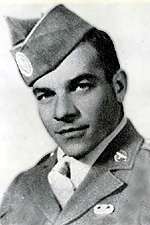 Lloyd G. McCarter | Private | 503rd Parachute Infantry Regiment | Corregidor Island, Philippines | 16–19 February 1945 | |
 Larry S. Pierce † | Sergeant | Headquarters Company, 1st Battalion (Airborne), 503rd Infantry Regiment, 173rd Airborne Brigade | near Ben Cat, Republic of Vietnam | 20 September 1965 | |
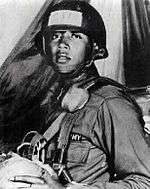 Milton L. Olive, III † | Private First Class | Company B, 2nd Battalion (Airborne), 503rd Infantry Regiment, 173rd Airborne Brigade | Phu Cuong, South Vietnam | 22 October 1965 | |
 Lawrence Joel | Sergeant First Class | 503rd Infantry Regiment, 173rd Airborne Brigade | near Bien Hoa, Vietnam | 8 November 1965 | |
 Alfred V. Rascon | Specialist Four | Headquarters Company, Medical Platoon, 503rd Infantry Regiment, 173rd Airborne Brigade | near Long Khánh Province, Vietnam | 16 March 1966 | |
 Charles B. Morris | Sergeant | Company A, 2nd Battalion (Airborne), 503rd Infantry Regiment, 173rd Airborne Brigade (Separate) | Republic of Vietnam | 29 June 1966 | |
 Don L. Michael † | Specialist Four | Company C, 4th Battalion, 503rd Infantry Regiment, 173rd Airborne Brigade | Republic of Vietnam | 8 April 1967 | |
 John Andrew Barnes, III † | Private First Class | 503rd Infantry Regiment, 173rd Airborne Brigade | Kontum, Vietnam | 12 November 1967 | [11] |
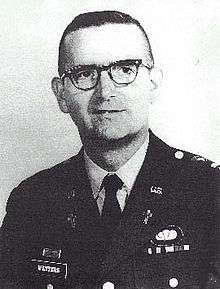 Charles J. Watters † | Chaplain (Major) | Army Chaplain Corps, 173rd Support Battalion, 503rd Infantry Regiment, 173rd Airborne Brigade | near Dak To Province, Republic of Vietnam | 19 November 1967 | |
Carlos J. Lozada † | Private First Class | 503rd Infantry Regiment, 173rd Airborne Brigade | Dak To, Republic of Vietnam | 20 November 1967 | |
 Michael R. Blanchfield † | Specialist Four | 503rd Infantry Regiment, 173rd Airborne Brigade | Binh Dinh Province, Republic of Vietnam | 3 July 1969 | |
 Glenn H. English Jr. † | Staff Sergeant | 503rd Infantry Regiment, 173rd Airborne Brigade | Phu My District, Republic of Vietnam | 7 September 1970 | |
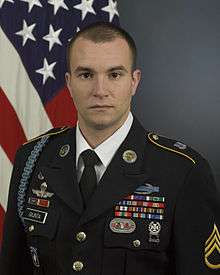 Salvatore Giunta | Staff Sergeant | 2nd Battalion, 503rd Infantry Regiment, 173rd Airborne Brigade | Korengal Valley, Kunar Province, Afghanistan | 25 October 2007 | |
 Kyle J. White | Specialist | 2nd Battalion, 503rd Infantry Regiment, 173rd Airborne Brigade | Aranas, Nuristan Province, Afghanistan | 9 November 2007 | [11] |
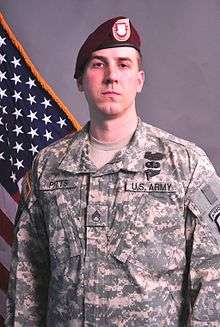 Ryan M. Pitts | Staff Sergeant | 2nd Battalion, 503rd Infantry Regiment, 173rd Airborne Brigade | Wanat, Kunar Province, Afghanistan | 13 July 2008 |
Silver Star recipients
Silver Star recipients:
- Vincent J. Stislow, PFC, I Co 3/503, New Guinea, 1943 (later DOW, 18 Feb 1945, Corregidor).
Paul A. NARROW, PFC, Corregidor 1945
- Ross H. Redding, PFC, Company B, 1st Battalion, 503rd Infantry, 173rd Airborne Brigade (Sep), Republic of Vietnam, November 8, 1965.[12]
- Harrison J. Meyer, PFC, D Co 1/503, Ramadi, Iraq, 2004.[13]
- Thomas E. Vitagliano, SSG, C Co 1/503rd, Ramadi, Iraq.[13]
- Christopher Choay, SSG, C Co 2/503, Afghanistan, 2005.
- Daniel T. Metcalfe, SFC, D Co 2/503, Sayyid Abad, Afghanistan, 2012.[14]
- Stephen E. Simmons, SSG, Company C, 2d Battalion (Airborne), 503d Parachute Infantry Regiment, 173d Airborne Brigade Combat Team.[15]
- Matthew Matlock, SSG, C Company 1/503 (ABN) OEF VII.
- Christopher T. Upp, SSG, Company HHC, 2d Battalion (Airborne), Chowkay Valley, Afghanistan, 2007 503d Parachute Infantry Regiment, 173d Airborne Brigade Combat Team.
In popular culture
- Restrepo (2010) is a documentary film about the Second Platoon, Battle Company, 2nd Battalion, 503rd Infantry Regiment (airborne) of the 173rd Airborne Brigade Combat Team in the Korangal Valley in Afghanistan.
- 84C MoPic : 1989 mock-up documentary of a Long Range Reconnaissance Patrol (LRRP) mission during the Vietnam War. C Co., 2/503, 173rd (ABN) BDE, Bon Song, Vietnam
Lineage and Honors
Lineage
- Constituted 24 February 1942 in the Army of the United States as the 503d Parachute Infantry (1st Battalion concurrently consolidated with the 503d Parachute Battalion [constituted 14 March 1941 in the Army of the United States and activated 22 August 1941 at Fort Benning, Georgia] and 2d Battalion consolidated with the 504th Parachute Battalion [constituted 14 March 1941 in the Army of the United States and activated 5 October at Fort Benning, Georgia] and consolidated units designated as the 1st and 2d Battalion, 503d Parachute Infantry)
- Regiment (less 1st, 2d and 3d Battalions) activated 2 March 1942 at Fort Benning, Georgia
- (3d Battalion activated 8 June 1942 at Fort Bragg, North Carolina)
- (2d Battalion reorganized and redesignated 2 November 1942 as the 2d Battalion, 509th Parachute Infantry- hereafter separate lineage; new 2d Battalion, 502d Infantry concurrently activated in Australia)
- Regiment inactivated 24 December 1945 at Camp Anza, California
- Redesignated 1 February 1951 as the 503d Airborne Infantry, allotted to the Regular Army, and assigned to the 11th Airborne Division
- Activated 2 March 1951 at Fort Campbell, Kentucky
- Relieved 1 March 1957 from assignment to the 11th Airborne Division' concurrently reorganized and redesignated as the 503d Infantry, a parent regiment under the Combat Arms Regimental System
- Withdrawn 16 December 1986 from the Combat Arms Regimental System and reorganized under the United States Army Regimental System[16]
- Redesignated 1 October 2005 as the 503d Infantry Regiment[17][18]
Campaign Participation Credit
- World War II: New Guinea; Leyte; Luzon (with arrowhead); Southern Philippines
- Vietnam: Defense; Counteroffensive; Counteroffensive, Phase II (with arrowhead); Counteroffensive, Phase III; Counteroffensive, Phase IV; Counteroffensive, Phase V; Counteroffensive, Phase VI; Tet 69/Counteroffensive; Summer-Fall 1969; Winter-Spring 1970; Sanctuary Counteroffensive; Counteroffensive, Phase VII; Consolidation I[16]
Note: The published Army lineage predates the War on Terrorism. Comparison of the deployment dates of regimental elements with the War on Terrorism campaigns estimates that the battalion will be credited with participation in the six campaigns listed.
Decorations
- Presidential Unit Citation (Army) for CORREGIDOR
- Presidential Unit Citation (Army) for BIEN HOA
- Presidential Unit Citation (Army) for PHUOC VINH
- Presidential Unit Citation (Army) for DAK TO
- Presidential Unit Citation (Navy) for VIETNAM 1966
- Valorous Unit Award for TUY HOA
- Meritorious Unit Commendation (Army) for VIETNAM 1965-1967
- Philippine Presidential Unit Citation for 17 OCTOBER 1944 TO 4 JULY 1945
- Navy Unit Commendation (Navy) for AR RAMADI 2005[16]
Heraldry
Distinctive Unit Insignia

- Description/Blazon: A silver color metal and enamel device 1 1/8 inches (2.86 cm) in height overall consisting of the shield and motto of the coat of arms.
- Symbolism: The colors, blue and white, are those of Infantry. The inverted triangle terminating in the broken fort symbolizes the drop on Corregidor, whereas the three parachutes represent the three other battle honors awarded the organization.
- Background: The distinctive unit insignia was originally approved for the 503d Airborne Infantry Regiment on 28 Apr 1952. It was amended to change the motto on 28 May 1952. On 29 Jun 1958 the insignia was redesignated to the 503d Infantry.[21]
Coat of Arms
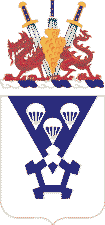
- Description/Blazon
- Shield: Argent, a fort voided Azure, pierced to the center by a pile of the second counterchanged with the fort and bearing three parachutes of the first, two and one.
- Crest: On a wreath of the colors Argent and Azure a dragon passant Gules in front of three swords, points conjoined in base Proper, with hand grips of the second nailed and edged Or, in center overall a carved arrowhead point down of the last.
- Motto: THE ROCK.
- Symbolism
- Shield: The colors, blue and white, are those of Infantry. The inverted triangle terminating in the broken fort symbolizes the drop on Corregidor, whereas the three parachutes represent the three other battle honors awarded the organization.
- Crest: The dragon and the colors scarlet and yellow refer to the Republic of Vietnam where the Regiment participated in thirteen campaigns; scarlet also alludes to the award of the Meritorious Unit Commendation. The unit's participation in an assault landing during the Counteroffensive, Phase II, is indicated by the arrowhead and the swords with blue grips represent the Presidential Unit Citation awarded three times for service in the Republic of Vietnam.
- Background: The Coat of Arms was originally approved for the 503d Airborne Infantry Regiment on 28 Apr 1952. It was amended to change the motto on 28 May 1952. The coat of arms was redesignated for the 503d Infantry on 29 Jan 1958.[21]
References
- ↑ http://corregidor.org/503_abbott/503%20Chronology.htm
- ↑ Morison, Samuel Eliot (1953). History of United States Naval Operations in World War II: New Guinea and the Marianas, March 1944-August 1944. University of Illinois Press. p. 139. ISBN 978-0-252-07038-9. Retrieved 20 May 2013.
- ↑ Headquarters, Department of the Army. "General Orders 1986-40: Organizational Actions of Units to Form the 503d Infantry Regiment Under the US Army Regimental System (USARS)." 24 November 1986. Web. Accessed 24 November 2015. <http://www.apd.army.mil/pdffiles/go8640.pdf>.
- ↑ Interview with LTC James Raymer Combat Studies Institute 24 February 2006
- ↑ "U.S. Troops Fortify Iraqi Polling Stations", Stars and Stripes, 28 January 2005
- ↑ "Into the Valley of Death". Junger, Sebastian; Vanity Fair; January 2008
- ↑ "Battle Company Is Out There"; Rubin, Elizabeth; The New York Times Sunday Magazine; February, 2008
- ↑ Headquarters, Department of the Army. "General Orders 2013-07." 10 June 2013. Web. Accessed 23 November 2015. <http://www.apd.army.mil/pdffiles/go1307.pdf>.
- ↑ U.S. Army Human Resources Command. "Permanent Order 299-18." 26 October 2011. Web. Accessed 23 November 2015. <http://www.history.army.mil/html/forcestruc/HRC/2011/299-18_20111026_HRCMD.pdf>.
- ↑ Tan, Michelle (16 January 2012). "Vicenza unit earns 2 awards for Afghan missions". Army Times. Retrieved 13 June 2014.
- 1 2 http://corregidor.org/heritage_battalion/moh/barnes.html
- ↑ General Orders No. 802, dated Feb. 5, 1966, Headquarters U.S. Army Vietnam, APO San Francisco 96307.
- 1 2 "U.S. Army Citations for awards of the Silver Star in the Global War on Terrorism". Home of Heroes. Retrieved 13 June 2014.
- ↑ "Valor awards for Daniel T. Metcalfe". Military Times Hall of Valor. Retrieved 13 June 2014.
- ↑ "Valor awards for Stephen E. Simmons". Military Times Hall of Valor. Retrieved 13 June 2014.
- 1 2 3 "Lineage and Honors Information: 503d Infantry (The Rock Regiment)." U.S. Army Center for Military History. 7 March 2001. Web. Accessed 23 November 2015. <http://www.history.army.mil/html/forcestruc/lineages/branches/inf/0503in.htm>.
- ↑ "Lineage and Honors Information: 1st Battalion, 503d Infantry Regiment (The Rock Regiment)." U.S. Army Center for Military History. 31 January 2012. Web. Accessed 23 November 2015. <http://www.history.army.mil/html/forcestruc/lineages/branches/inf/0503in001bn.htm>.
- ↑ "Lineage and Honors Information: 2d Battalion, 503d Infantry Regiment (The Rock Regiment)." U.S. Army Center for Military History. 2 June 2010. Web. Accessed 23 November 2015. <http://www.history.army.mil/html/forcestruc/lineages/branches/inf/0503in002bn.htm>.
- ↑ Headquarters, Department of the Army. "General Orders 2006-10." 25 September 2006. Web. Accessed 24 November 2015. <https://www.hrc.army.mil/site/ASSETS/Awards/2014/New2014Awards/2006-10.pdf>.
- ↑ "Afghanistan Campaign Medal or Iraq Campaign Medal." The Adjutant General Directorate (TAGD). United States Army Human Resources Command. 6 August 2015. Web, accessed 12 October 2015. <https://www.hrc.army.mil/TAGD/Afghanistan%20Campaign%20Medal%20or%20Iraq%20Campaign%20Medal> Archived 11 September 2015 at the Wayback Machine..
- 1 2 "503d Infantry Regiment" The Institute of Heraldry. n.d. Web. Accessed 24 November 2015. <http://www.tioh.hqda.pentagon.mil/Catalog/HeraldryMulti.aspx?CategoryId=3733&grp=2&menu=Uniformed%20Services>.
External links
| Wikimedia Commons has media related to 503rd Infantry Regiment (United States). |
- The 1st Battalion, 503rd Infantry Regiment home page
- The 2nd Battalion, 503rd Infantry Regiment home page
- "'The Rock' is Ready", Stars and Stripes, 21 September 2004
